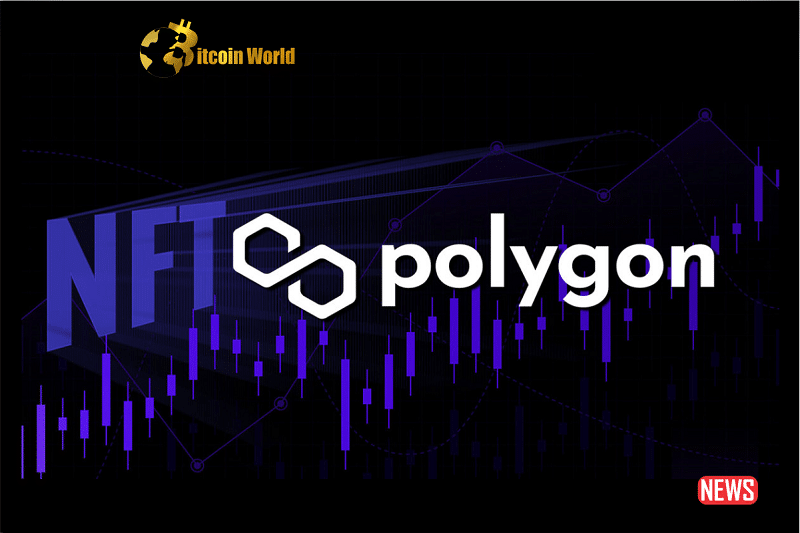Ever noticed how sometimes different parts of the crypto world seem to be dancing to entirely different tunes? That’s the fascinating situation unfolding with Polygon (MATIC) right now. While its NFT market is buzzing with activity, the price of its native token, MATIC, has seen a bit of a pullback. Let’s dive into this intriguing divergence and see what’s behind it.
Polygon’s NFT Scene: A Hub of Activity
Think of Polygon’s NFT space as a marketplace that’s suddenly become incredibly popular. Over the past week, things have really heated up:
- More Buyers and Sellers: The number of people buying and selling Polygon NFTs jumped by a solid 20%. That’s a significant influx of new participants!
- Transaction Surge: Get this – NFT transactions on Polygon shot up by over 25%! This indicates a lot more trading happening.
- Sales Volume Skyrockets: Perhaps the most eye-catching stat? The total value of Polygon NFTs traded went up by more than 35%. That’s a lot of digital collectibles changing hands!
So, who are the big players in this NFT boom on Polygon? According to Polygon Daily, a reliable source for all things Polygon, collections like y00ts, The Sandbox, and Ring Runnerz are leading the charge on OpenSea. Their popularity is a testament to the vibrant and growing NFT ecosystem on Polygon.
The Flip Side: MATIC’s Price Performance
Now, let’s shift gears and look at MATIC, the token that powers the Polygon network. Despite the positive vibes in the NFT market, MATIC’s price hasn’t followed suit. In fact, it’s seen a bit of a decline. Recent data shows a dip in MATIC’s price, with CoinMarketCap reporting a 3.4% drop in a 24-hour window. At the time of writing, MATIC was trading around $0.6677, holding its position as a top cryptocurrency with a market cap over $6.2 billion.
Why the Disconnect? Unpacking MATIC’s Price Dip
This is the million-dollar question, isn’t it? Why isn’t the NFT success translating directly to MATIC’s price? Here are some potential factors at play:
- Increased Selling Pressure: Data from CryptoQuant suggests more MATIC is being deposited on exchanges. This often indicates that holders are looking to sell, which can naturally put downward pressure on the price.
- Network Growth Slowdown: The rate at which new addresses are being created on the Polygon network has slowed down. This can sometimes signal less overall activity and potentially impact token value.
- MVRV Ratio Decline: The MVRV (Market Value to Realized Value) ratio, which helps gauge if an asset is over or undervalued, has also decreased for MATIC. This could be interpreted as a sign that the market believes MATIC’s current price might be a bit high.
Reading the Tea Leaves: What Technical Indicators Suggest
Let’s take a quick look at what the charts are saying about MATIC’s price action:
- Bollinger Bands: Currently, MATIC’s price seems to be in a period of lower volatility. This means we’re less likely to see a sudden, dramatic price surge in the immediate future.
- MACD (Moving Average Convergence Divergence): The MACD indicator hints at a possible bearish crossover. This is a technical signal that could suggest further price declines.
- MFI (Money Flow Index): The Money Flow Index for MATIC has taken a sharp turn downwards. This suggests that more money is flowing out of MATIC than into it, increasing the likelihood of continued price weakness.
The Bigger Picture: What Does This Mean?
So, what are the key takeaways from this interesting situation?
Key Observations:
- NFT Market Strength: Polygon has clearly established itself as a thriving hub for NFTs, attracting both creators and collectors.
- Price Action Disconnect: The current data highlights that positive developments in one area of a blockchain ecosystem don’t always immediately translate to price increases for its native token.
- Market Dynamics at Play: Factors like selling pressure and overall market sentiment can significantly influence token prices, sometimes overshadowing positive project-specific news.
Actionable Insights:
- For NFT Enthusiasts: Polygon remains a compelling platform for exploring and engaging with NFTs. The increased activity and sales volume are positive signs for the ecosystem.
- For MATIC Investors: Keep a close eye on market indicators, particularly on-chain data like exchange deposits and network growth, to gauge potential future price movements.
- For the Polygon Ecosystem: Understanding the factors that decouple NFT market success from token price is crucial for long-term sustainable growth. Exploring strategies to better align these aspects could be beneficial.
Looking Ahead
The crypto market is a dynamic and complex space. The current situation with Polygon and MATIC serves as a reminder that various factors can influence the price of a cryptocurrency. While the NFT market on Polygon is showing impressive growth, the price of MATIC is currently facing some headwinds. Monitoring the interplay between these different facets of the Polygon ecosystem will be key to understanding its future trajectory. Will the NFT boom eventually pull MATIC’s price upwards? Or will other market forces continue to exert downward pressure? Only time will tell, but one thing is clear: the story of Polygon is one to watch closely.
Disclaimer: The information provided is not trading advice, Bitcoinworld.co.in holds no liability for any investments made based on the information provided on this page. We strongly recommend independent research and/or consultation with a qualified professional before making any investment decisions.


